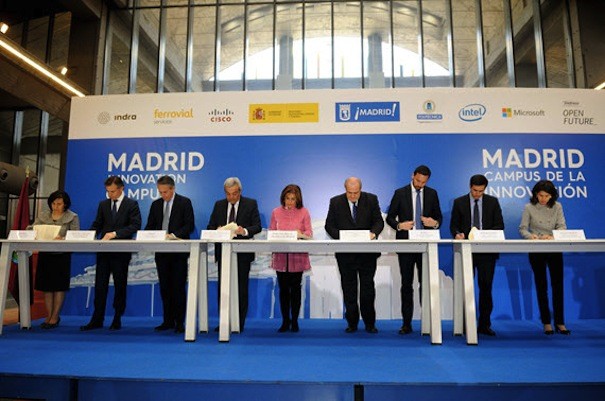Madrid is committed to 'R&D&I as a hallmark' with the future Innovation Campus
With the aim of turning the capital of Spain into “a nerve center of open innovation”, in the words of its mayor, Ana Botella, Madrid Campus de la Innovación inició ayer con la firma del protocolo de colaboración entre empresas del sector privado y público el camino para convertirse en un “centro pionero abierto a todos aquéllos que quieran desarrollar actividades de investigación y divulgación relacionadas con la innovación”.
La antigua fábrica de ascensores Boetticher, ubicada en el madrileño distrito de Villaverde, ha vuelto -doce años después de un complejo y dilatado proceso de rehabilitación de este clásico arquitectónico de la ingeniería industrial iniciado en 2003 por el entonces alcalde de Madrid, Alberto Ruíz Gallardón-, a situarse en el centro de atención político, económico y social bajo la denominación de Madrid Campus de la Innovación (antes conocido como la ‘Catedral de las Nuevas Tecnologías’).
He Ayuntamiento de Madrid, con su alcaldesa Ana Botella, al frente, firmó ayer mismo el protocolo general de colaboración con empresas del sector público y privado (en su mayoría) para iniciar a corto plazo este proyecto con el objetivo de crear “un centro pionero de innovación abierta y apoyo al emprendimiento en la capital”, tal y como subrayó.
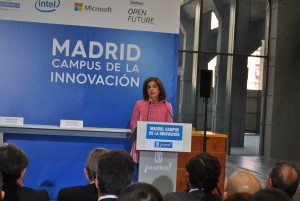 This initiative, en la que se han invertido hasta ahora más de 30 millones de euros sin que se tenga información sobre la partida dedicada a cada área y proyectos, cuenta con la colaboración de empresas tecnológicas como Cisco, Indra, Intel, Microsoft y Telefónica, con aportaciones de Philips e IBM, así como con la Secretaría de Estado de Telecomunicaciones; Universidad Politécnica de Madrid (UPM) y Ferrovial Servicios, además del consistorio madrileño.
This initiative, en la que se han invertido hasta ahora más de 30 millones de euros sin que se tenga información sobre la partida dedicada a cada área y proyectos, cuenta con la colaboración de empresas tecnológicas como Cisco, Indra, Intel, Microsoft y Telefónica, con aportaciones de Philips e IBM, así como con la Secretaría de Estado de Telecomunicaciones; Universidad Politécnica de Madrid (UPM) y Ferrovial Servicios, además del consistorio madrileño.
Durante su intervención, Botella ha subrayado que “Madrid es la región que más invierte y más personal dedica a la I+D de España. El esfuerzo inversor en 2013 fue de 3.434 million euros, lo que equivale al 26,4% del total nacional, empleando para ello a 47.609 personas, que suponen a su vez el 23,4% del total de España”.
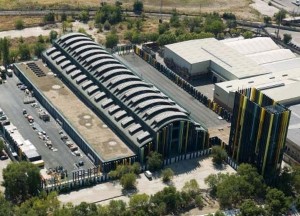 Según los datos aportados por la regidora, la inversión en la partida de I+D se sitúa en el 2,45% del PIB de Madrid, “lo que nos sitúa por encima de la media de la Unión Europea, que equivale al 2,07% de su PIB”, al tiempo que ha destacado la labor de todos los agentes implicados: “en nuestra ciudad se concentran las empresas responsables de un 56,7% de esa inversión; las administraciones, que contribuyen con el 25,1%; y las universidades, que aportan el 18,1%”.
Según los datos aportados por la regidora, la inversión en la partida de I+D se sitúa en el 2,45% del PIB de Madrid, “lo que nos sitúa por encima de la media de la Unión Europea, que equivale al 2,07% de su PIB”, al tiempo que ha destacado la labor de todos los agentes implicados: “en nuestra ciudad se concentran las empresas responsables de un 56,7% de esa inversión; las administraciones, que contribuyen con el 25,1%; y las universidades, que aportan el 18,1%”.
Tanto Ana Botella, como el secretario de Estado de Telecomunicaciones y Sociedad de la Información, Víctor Calvo-Sotelo, y el rector de la Universidad Politécnica de Madrid (UPM), Carlos Conde, han puesto especial énfasis en sus intervenciones en que “Madrid Campus de la Innovación es un proyecto abierto a todos. A los ciudadanos, que deben colaborar con sus aportaciones y sugerencias; a los estudiantes y a las universidades, que deben aportar sus capacidades, sus ideas y su espíritu transformador. A las pymes, que tendrán en el campus una plataforma ideal en la que exponer sus soluciones. A las grandes empresas, que aportarán medios técnicos y económicos suficientes para el avance de iniciativas y proyectos, su capacidad de formación y tutelaje”.
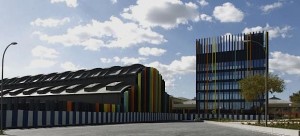 La firma del protocolo de este proyecto se ha materializado con Ana Botella, junto con Carlos Conde; el director general de Cisco España, José Manuel Petisco; el consejero delegado de Ferrovial Servicios, Santiago Olivares; la directora general de Indra, Emma Fernández; el director general de Intel España, Portugal, Italia, Grecia e Israel, Norberto Mateos; el director de sector público de Microsoft Ibérica, Gonzalo Díe Socias, y la managing director de Telefónica Open Future, Ana Segurado.
La firma del protocolo de este proyecto se ha materializado con Ana Botella, junto con Carlos Conde; el director general de Cisco España, José Manuel Petisco; el consejero delegado de Ferrovial Servicios, Santiago Olivares; la directora general de Indra, Emma Fernández; el director general de Intel España, Portugal, Italia, Grecia e Israel, Norberto Mateos; el director de sector público de Microsoft Ibérica, Gonzalo Díe Socias, y la managing director de Telefónica Open Future, Ana Segurado.
12.000 metros cuadrados para emprender
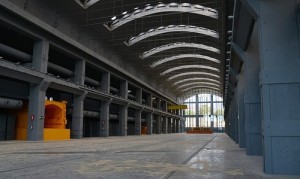 La antigua nave industrial de Boetticher, built in 1944 por el ingeniero Eduardo Torroja, que acogerá Madrid Campus de la Innovación cuenta con más de 12.000 metros cuadrados de superficie que se estructuran en tres cuerpos, a modo de basílica y con grandes bóvedas de hormigón para dejar entrar la luz, por lo que es conocida popularmente como ‘la catedral industrial’ o ‘catedral Torroja’ y motivo por el cual en el proyecto iniciado por Ruíz Gallardón era la ‘Catedral de las nuevas tecnologías’.
La antigua nave industrial de Boetticher, built in 1944 por el ingeniero Eduardo Torroja, que acogerá Madrid Campus de la Innovación cuenta con más de 12.000 metros cuadrados de superficie que se estructuran en tres cuerpos, a modo de basílica y con grandes bóvedas de hormigón para dejar entrar la luz, por lo que es conocida popularmente como ‘la catedral industrial’ o ‘catedral Torroja’ y motivo por el cual en el proyecto iniciado por Ruíz Gallardón era la ‘Catedral de las nuevas tecnologías’.
El campus cuenta con cinco espacios diferenciados, a falta de dotación mobiliaria y tecnológica, para desarrollar las distintas actividades, como el pabellón o área principal (of 5.977 m2) formada por las tres naves en la que se desarrollarán exposiciones; la torre, un edificio de nueva construcción distribuidos en un vestíbulo y cinco plantas; las aulas, distribuidas en cinco salas de 200 a 40 m2 para formación; el auditorio, con capacidad para más de seiscientas personas, y los denominados contenedores, compuesto por veintiséis pequeñas oficinas modulares para emprendedores.
Did you like this article?
Subscribe to our NEWSLETTER and you won't miss anything.



